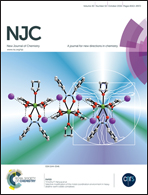Slipped-cofacial J-type phthalocyanine dimers as potential non-linear absorbers for optical limiting applications†
Abstract
We found, for the first time, that in the presence of HClO4, a slipped-cofacial magnesium J-type phthalocyanine dimer is subjected to demetallation, providing a thermally stable metal-free derivative, as proven by NMR and UV/Vis spectroscopy, as well as by MALDI-TOF mass spectrometry. Our thermoanalytical study demonstrated the high thermal stability of the dimeric ligand (up to 614 °C). The presence of tert-butyl substituents in the dimeric structures allowed us to discover, with the help of field emission scanning electron microscopy (FE-SEM), ordered phases, represented as threads composed of about 200 nm diameter circles, unlike the corresponding monomers, in which similar circles or triangles are scattered randomly. The interaction of the metal-free dimer with magnesium acetate gave an initial dimeric complex with intrinsic spectral properties. Simulation of the optical limiting (OL) properties using the finite field TDDFT (FF-TDDFT) approach (PBE/aug-cc-pVDZ) revealed that the limiting effect for J-type dimers is more pronounced in the visible region, whereas in the near-IR region, at low input fields, they can be used as linear optical filters.



 Please wait while we load your content...
Please wait while we load your content...